The Impact of Multiple Sclerosis on Nervous System Functionality
VerifiedAdded on 2020/04/21
|25
|5070
|63
AI Summary
Multiple Sclerosis (MS) is a chronic autoimmune disorder that primarily affects the central nervous system, leading to significant neurological impairments. This assignment examines the pathophysiological mechanisms underlying MS, focusing on how it disrupts nerve signal transmission through demyelination and neuronal damage. Symptoms vary widely but commonly include sensory disturbances, motor dysfunction, cognitive deficits, and fatigue. The assignment also reviews current disease-modifying therapies aimed at slowing disease progression, managing symptoms, and improving patient quality of life. These treatments encompass immunomodulatory agents, monoclonal antibodies, and emerging therapeutic strategies targeting specific pathways involved in MS pathogenesis. Understanding these aspects is crucial for developing effective management plans and advancing research into novel treatment modalities.
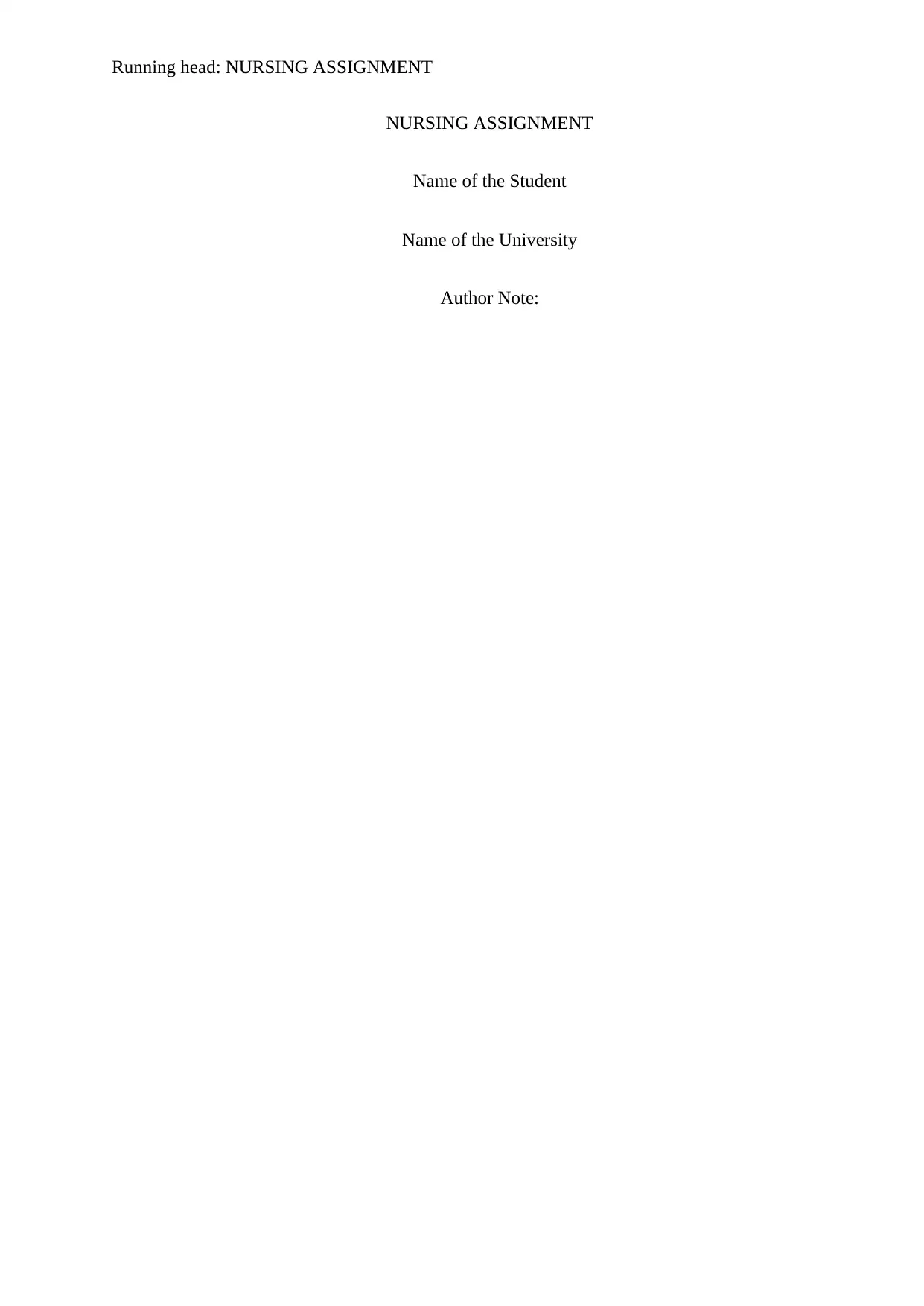
Running head: NURSING ASSIGNMENT
NURSING ASSIGNMENT
Name of the Student
Name of the University
Author Note:
NURSING ASSIGNMENT
Name of the Student
Name of the University
Author Note:
Paraphrase This Document
Need a fresh take? Get an instant paraphrase of this document with our AI Paraphraser
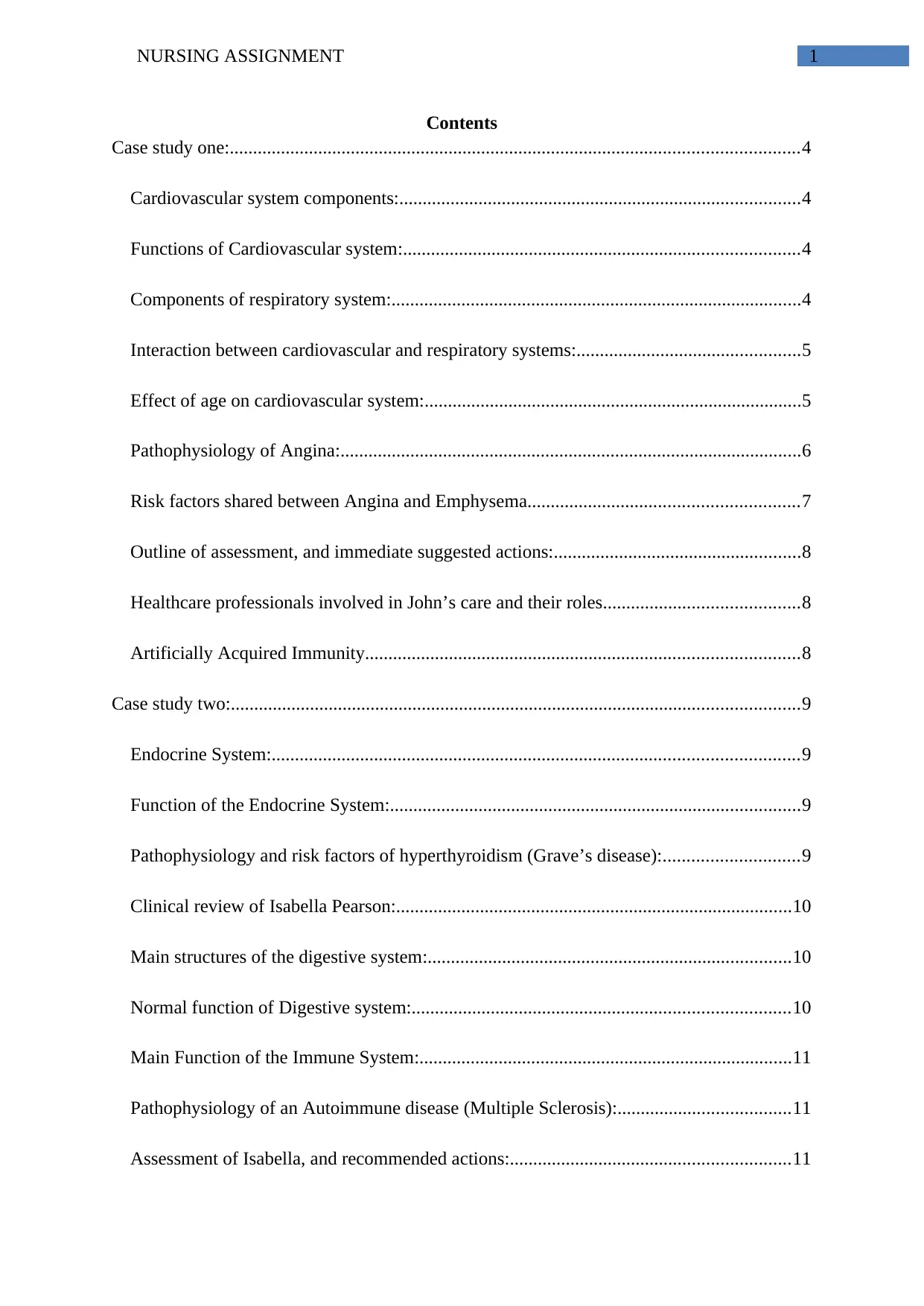
NURSING ASSIGNMENT 1
Contents
Case study one:..........................................................................................................................4
Cardiovascular system components:......................................................................................4
Functions of Cardiovascular system:.....................................................................................4
Components of respiratory system:........................................................................................4
Interaction between cardiovascular and respiratory systems:................................................5
Effect of age on cardiovascular system:.................................................................................5
Pathophysiology of Angina:...................................................................................................6
Risk factors shared between Angina and Emphysema..........................................................7
Outline of assessment, and immediate suggested actions:.....................................................8
Healthcare professionals involved in John’s care and their roles..........................................8
Artificially Acquired Immunity.............................................................................................8
Case study two:..........................................................................................................................9
Endocrine System:.................................................................................................................9
Function of the Endocrine System:........................................................................................9
Pathophysiology and risk factors of hyperthyroidism (Grave’s disease):.............................9
Clinical review of Isabella Pearson:.....................................................................................10
Main structures of the digestive system:..............................................................................10
Normal function of Digestive system:.................................................................................10
Main Function of the Immune System:................................................................................11
Pathophysiology of an Autoimmune disease (Multiple Sclerosis):.....................................11
Assessment of Isabella, and recommended actions:............................................................11
Contents
Case study one:..........................................................................................................................4
Cardiovascular system components:......................................................................................4
Functions of Cardiovascular system:.....................................................................................4
Components of respiratory system:........................................................................................4
Interaction between cardiovascular and respiratory systems:................................................5
Effect of age on cardiovascular system:.................................................................................5
Pathophysiology of Angina:...................................................................................................6
Risk factors shared between Angina and Emphysema..........................................................7
Outline of assessment, and immediate suggested actions:.....................................................8
Healthcare professionals involved in John’s care and their roles..........................................8
Artificially Acquired Immunity.............................................................................................8
Case study two:..........................................................................................................................9
Endocrine System:.................................................................................................................9
Function of the Endocrine System:........................................................................................9
Pathophysiology and risk factors of hyperthyroidism (Grave’s disease):.............................9
Clinical review of Isabella Pearson:.....................................................................................10
Main structures of the digestive system:..............................................................................10
Normal function of Digestive system:.................................................................................10
Main Function of the Immune System:................................................................................11
Pathophysiology of an Autoimmune disease (Multiple Sclerosis):.....................................11
Assessment of Isabella, and recommended actions:............................................................11
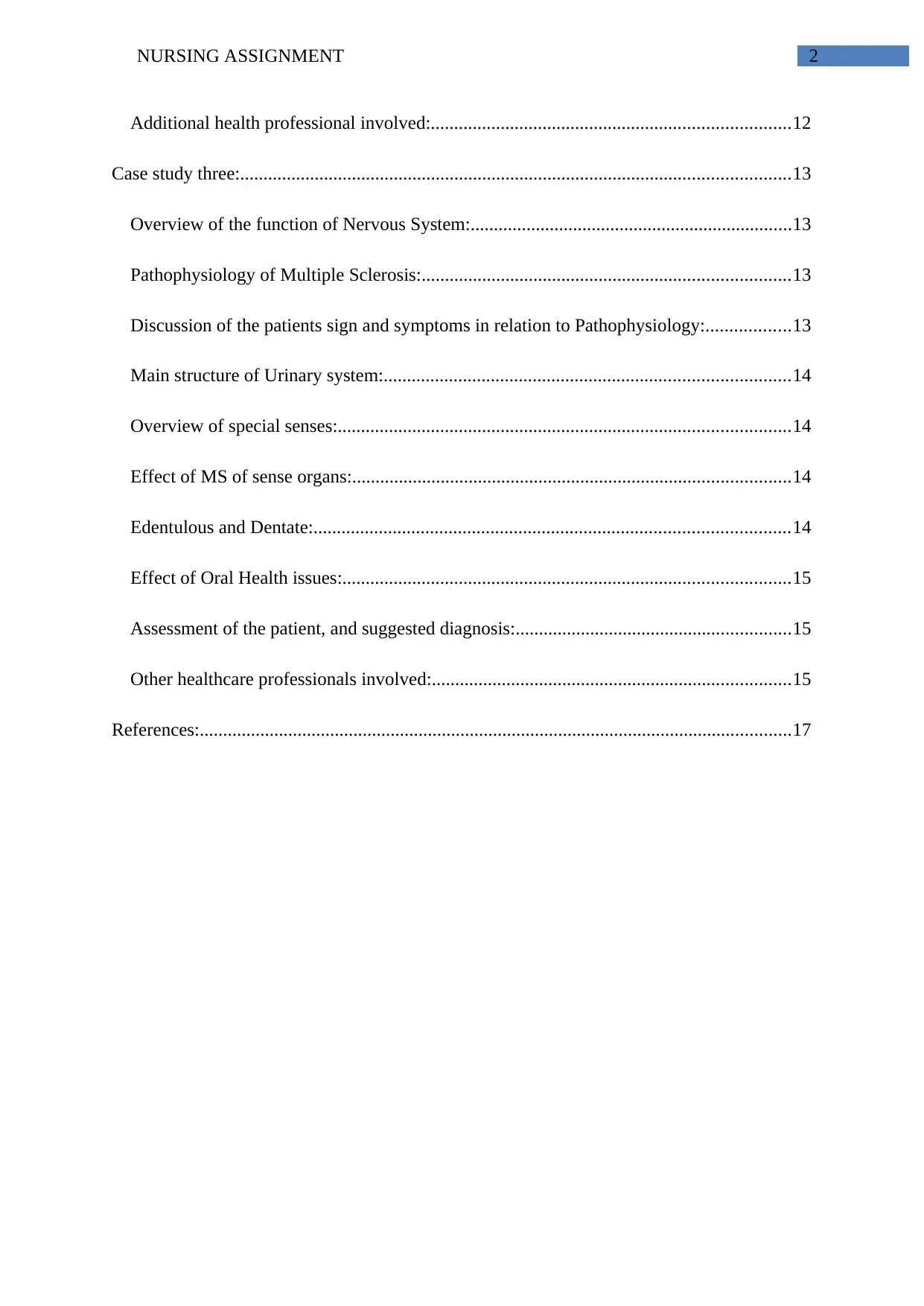
NURSING ASSIGNMENT 2
Additional health professional involved:.............................................................................12
Case study three:......................................................................................................................13
Overview of the function of Nervous System:.....................................................................13
Pathophysiology of Multiple Sclerosis:...............................................................................13
Discussion of the patients sign and symptoms in relation to Pathophysiology:..................13
Main structure of Urinary system:.......................................................................................14
Overview of special senses:.................................................................................................14
Effect of MS of sense organs:..............................................................................................14
Edentulous and Dentate:......................................................................................................14
Effect of Oral Health issues:................................................................................................15
Assessment of the patient, and suggested diagnosis:...........................................................15
Other healthcare professionals involved:.............................................................................15
References:...............................................................................................................................17
Additional health professional involved:.............................................................................12
Case study three:......................................................................................................................13
Overview of the function of Nervous System:.....................................................................13
Pathophysiology of Multiple Sclerosis:...............................................................................13
Discussion of the patients sign and symptoms in relation to Pathophysiology:..................13
Main structure of Urinary system:.......................................................................................14
Overview of special senses:.................................................................................................14
Effect of MS of sense organs:..............................................................................................14
Edentulous and Dentate:......................................................................................................14
Effect of Oral Health issues:................................................................................................15
Assessment of the patient, and suggested diagnosis:...........................................................15
Other healthcare professionals involved:.............................................................................15
References:...............................................................................................................................17
⊘ This is a preview!⊘
Do you want full access?
Subscribe today to unlock all pages.

Trusted by 1+ million students worldwide
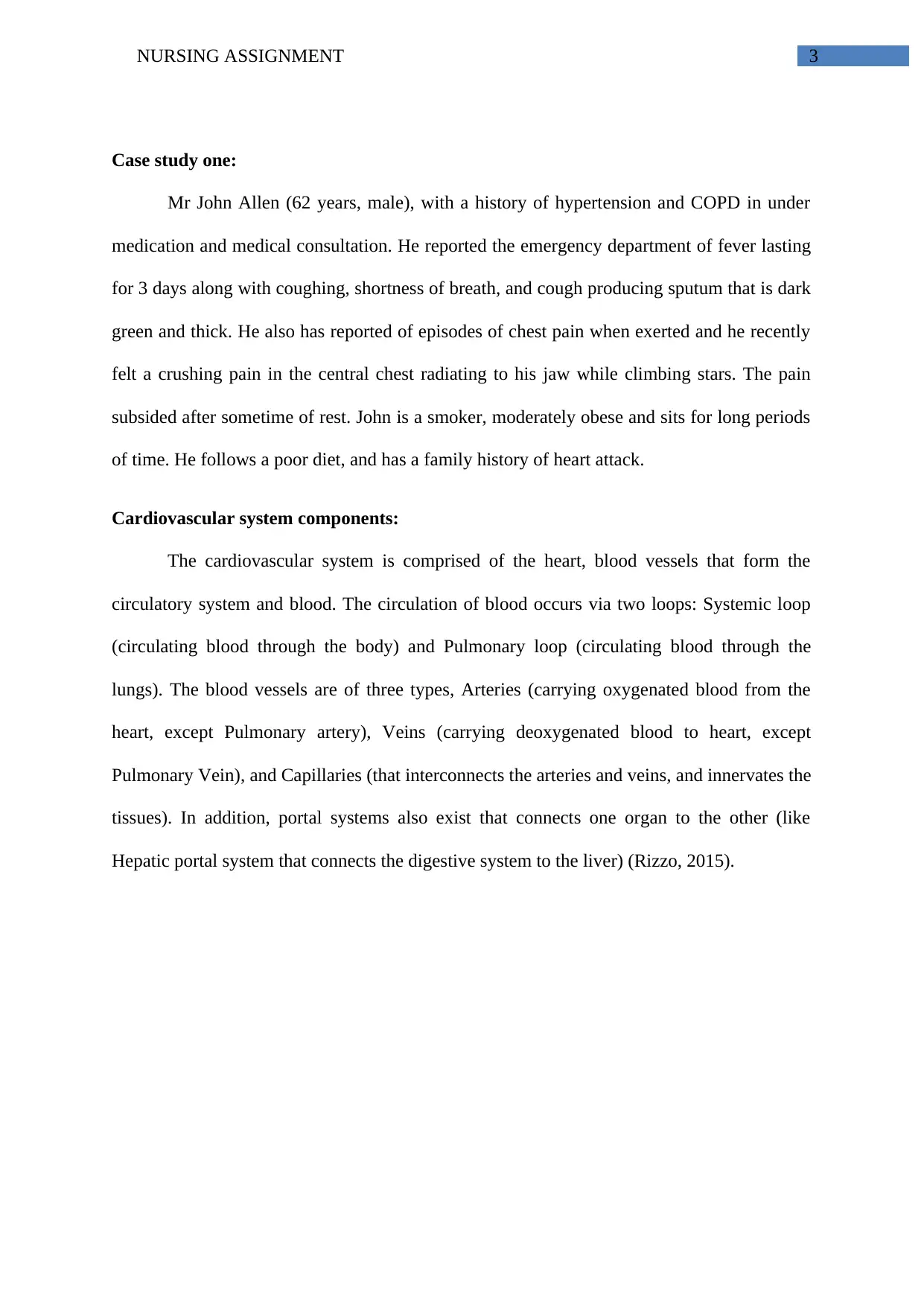
NURSING ASSIGNMENT 3
Case study one:
Mr John Allen (62 years, male), with a history of hypertension and COPD in under
medication and medical consultation. He reported the emergency department of fever lasting
for 3 days along with coughing, shortness of breath, and cough producing sputum that is dark
green and thick. He also has reported of episodes of chest pain when exerted and he recently
felt a crushing pain in the central chest radiating to his jaw while climbing stars. The pain
subsided after sometime of rest. John is a smoker, moderately obese and sits for long periods
of time. He follows a poor diet, and has a family history of heart attack.
Cardiovascular system components:
The cardiovascular system is comprised of the heart, blood vessels that form the
circulatory system and blood. The circulation of blood occurs via two loops: Systemic loop
(circulating blood through the body) and Pulmonary loop (circulating blood through the
lungs). The blood vessels are of three types, Arteries (carrying oxygenated blood from the
heart, except Pulmonary artery), Veins (carrying deoxygenated blood to heart, except
Pulmonary Vein), and Capillaries (that interconnects the arteries and veins, and innervates the
tissues). In addition, portal systems also exist that connects one organ to the other (like
Hepatic portal system that connects the digestive system to the liver) (Rizzo, 2015).
Case study one:
Mr John Allen (62 years, male), with a history of hypertension and COPD in under
medication and medical consultation. He reported the emergency department of fever lasting
for 3 days along with coughing, shortness of breath, and cough producing sputum that is dark
green and thick. He also has reported of episodes of chest pain when exerted and he recently
felt a crushing pain in the central chest radiating to his jaw while climbing stars. The pain
subsided after sometime of rest. John is a smoker, moderately obese and sits for long periods
of time. He follows a poor diet, and has a family history of heart attack.
Cardiovascular system components:
The cardiovascular system is comprised of the heart, blood vessels that form the
circulatory system and blood. The circulation of blood occurs via two loops: Systemic loop
(circulating blood through the body) and Pulmonary loop (circulating blood through the
lungs). The blood vessels are of three types, Arteries (carrying oxygenated blood from the
heart, except Pulmonary artery), Veins (carrying deoxygenated blood to heart, except
Pulmonary Vein), and Capillaries (that interconnects the arteries and veins, and innervates the
tissues). In addition, portal systems also exist that connects one organ to the other (like
Hepatic portal system that connects the digestive system to the liver) (Rizzo, 2015).
Paraphrase This Document
Need a fresh take? Get an instant paraphrase of this document with our AI Paraphraser
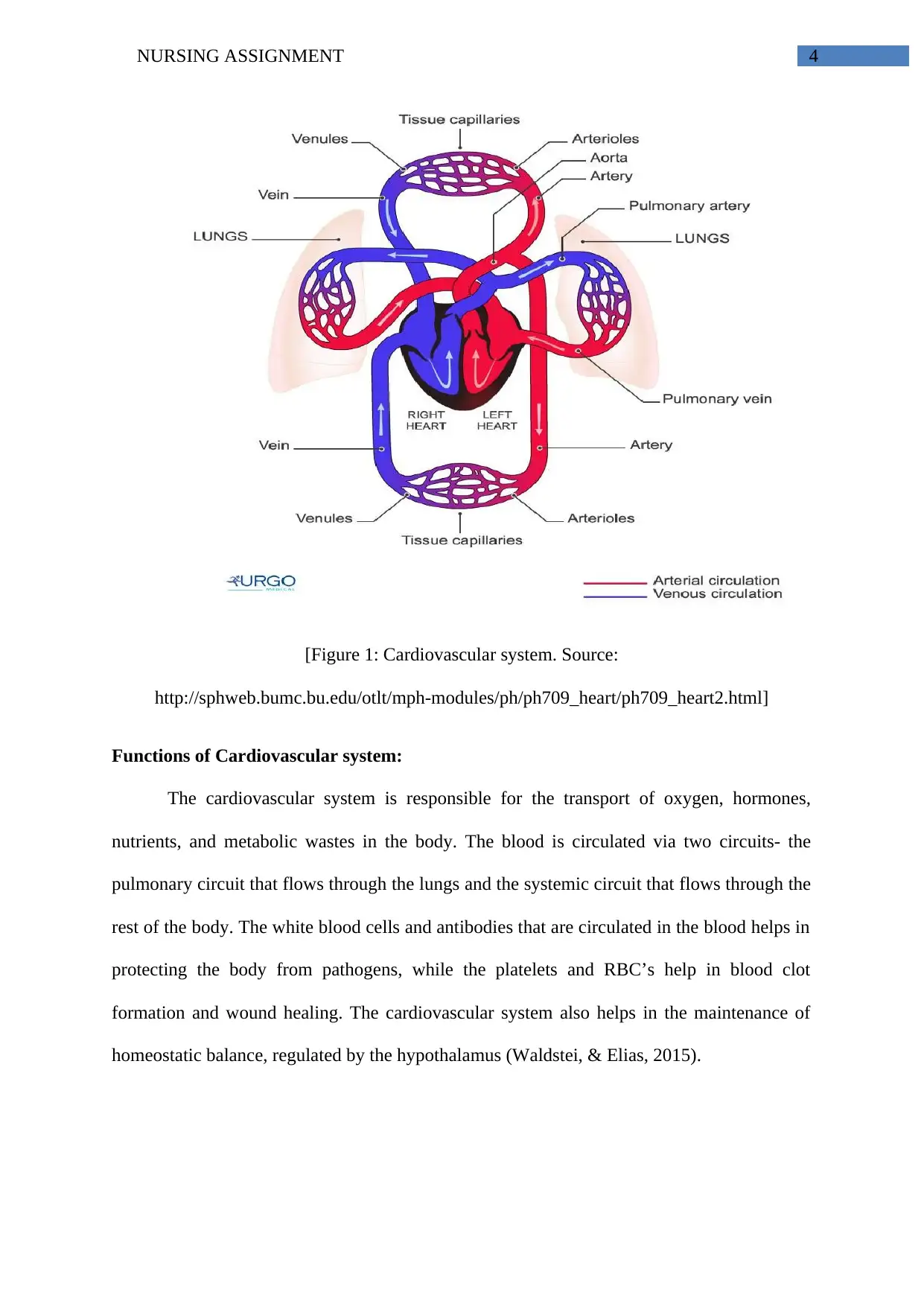
NURSING ASSIGNMENT 4
[Figure 1: Cardiovascular system. Source:
http://sphweb.bumc.bu.edu/otlt/mph-modules/ph/ph709_heart/ph709_heart2.html]
Functions of Cardiovascular system:
The cardiovascular system is responsible for the transport of oxygen, hormones,
nutrients, and metabolic wastes in the body. The blood is circulated via two circuits- the
pulmonary circuit that flows through the lungs and the systemic circuit that flows through the
rest of the body. The white blood cells and antibodies that are circulated in the blood helps in
protecting the body from pathogens, while the platelets and RBC’s help in blood clot
formation and wound healing. The cardiovascular system also helps in the maintenance of
homeostatic balance, regulated by the hypothalamus (Waldstei, & Elias, 2015).
[Figure 1: Cardiovascular system. Source:
http://sphweb.bumc.bu.edu/otlt/mph-modules/ph/ph709_heart/ph709_heart2.html]
Functions of Cardiovascular system:
The cardiovascular system is responsible for the transport of oxygen, hormones,
nutrients, and metabolic wastes in the body. The blood is circulated via two circuits- the
pulmonary circuit that flows through the lungs and the systemic circuit that flows through the
rest of the body. The white blood cells and antibodies that are circulated in the blood helps in
protecting the body from pathogens, while the platelets and RBC’s help in blood clot
formation and wound healing. The cardiovascular system also helps in the maintenance of
homeostatic balance, regulated by the hypothalamus (Waldstei, & Elias, 2015).
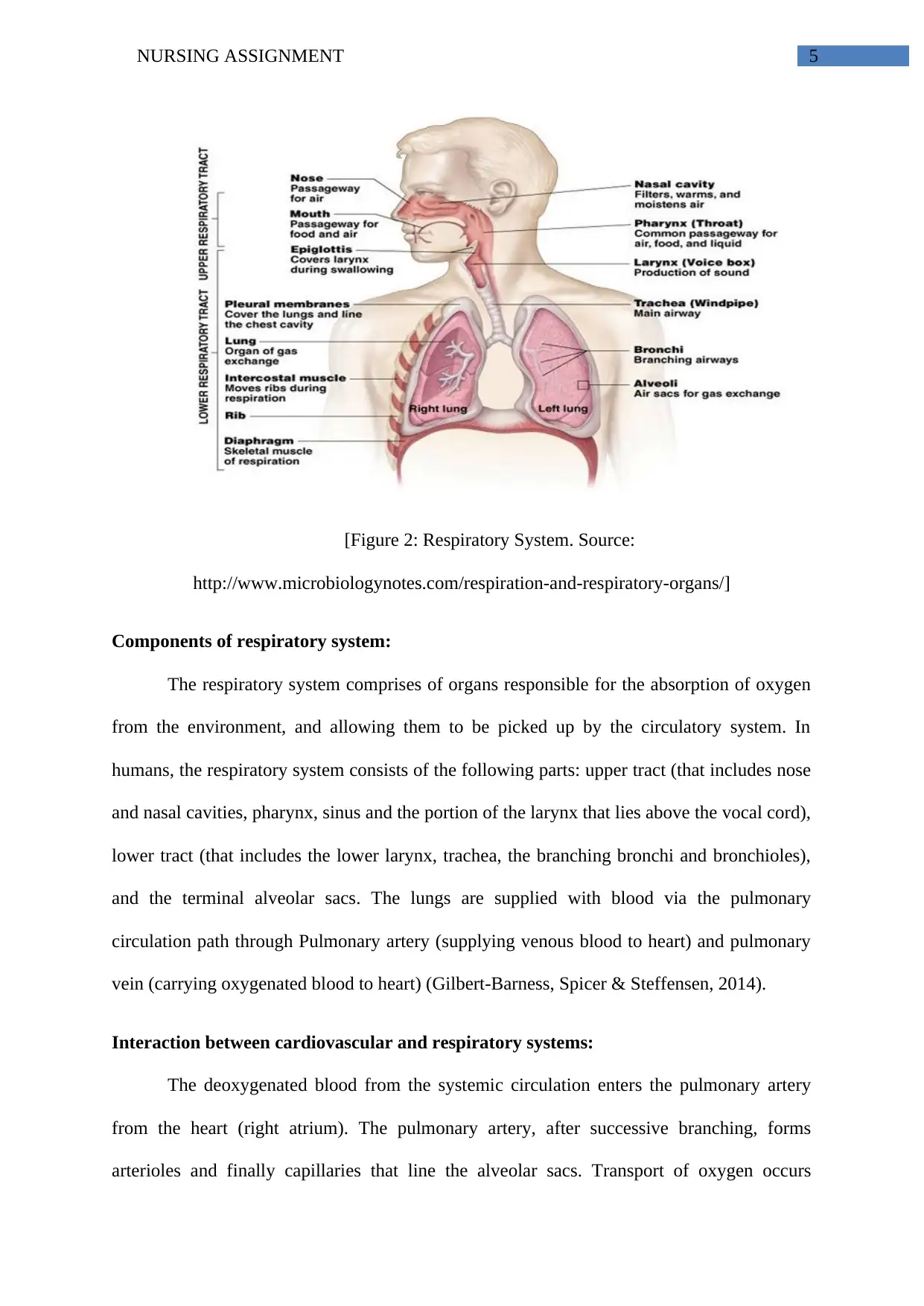
NURSING ASSIGNMENT 5
[Figure 2: Respiratory System. Source:
http://www.microbiologynotes.com/respiration-and-respiratory-organs/]
Components of respiratory system:
The respiratory system comprises of organs responsible for the absorption of oxygen
from the environment, and allowing them to be picked up by the circulatory system. In
humans, the respiratory system consists of the following parts: upper tract (that includes nose
and nasal cavities, pharynx, sinus and the portion of the larynx that lies above the vocal cord),
lower tract (that includes the lower larynx, trachea, the branching bronchi and bronchioles),
and the terminal alveolar sacs. The lungs are supplied with blood via the pulmonary
circulation path through Pulmonary artery (supplying venous blood to heart) and pulmonary
vein (carrying oxygenated blood to heart) (Gilbert-Barness, Spicer & Steffensen, 2014).
Interaction between cardiovascular and respiratory systems:
The deoxygenated blood from the systemic circulation enters the pulmonary artery
from the heart (right atrium). The pulmonary artery, after successive branching, forms
arterioles and finally capillaries that line the alveolar sacs. Transport of oxygen occurs
[Figure 2: Respiratory System. Source:
http://www.microbiologynotes.com/respiration-and-respiratory-organs/]
Components of respiratory system:
The respiratory system comprises of organs responsible for the absorption of oxygen
from the environment, and allowing them to be picked up by the circulatory system. In
humans, the respiratory system consists of the following parts: upper tract (that includes nose
and nasal cavities, pharynx, sinus and the portion of the larynx that lies above the vocal cord),
lower tract (that includes the lower larynx, trachea, the branching bronchi and bronchioles),
and the terminal alveolar sacs. The lungs are supplied with blood via the pulmonary
circulation path through Pulmonary artery (supplying venous blood to heart) and pulmonary
vein (carrying oxygenated blood to heart) (Gilbert-Barness, Spicer & Steffensen, 2014).
Interaction between cardiovascular and respiratory systems:
The deoxygenated blood from the systemic circulation enters the pulmonary artery
from the heart (right atrium). The pulmonary artery, after successive branching, forms
arterioles and finally capillaries that line the alveolar sacs. Transport of oxygen occurs
⊘ This is a preview!⊘
Do you want full access?
Subscribe today to unlock all pages.

Trusted by 1+ million students worldwide
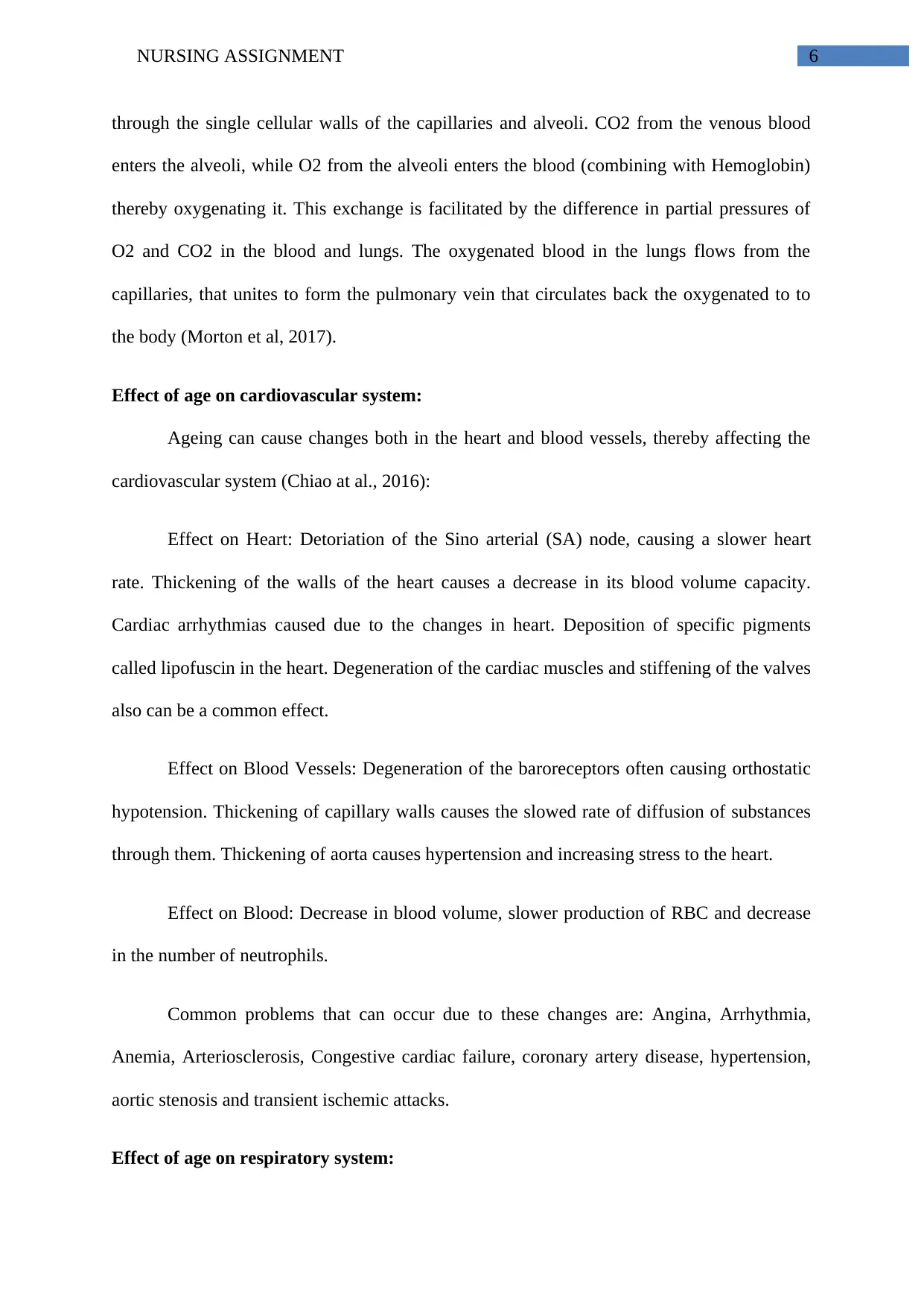
NURSING ASSIGNMENT 6
through the single cellular walls of the capillaries and alveoli. CO2 from the venous blood
enters the alveoli, while O2 from the alveoli enters the blood (combining with Hemoglobin)
thereby oxygenating it. This exchange is facilitated by the difference in partial pressures of
O2 and CO2 in the blood and lungs. The oxygenated blood in the lungs flows from the
capillaries, that unites to form the pulmonary vein that circulates back the oxygenated to to
the body (Morton et al, 2017).
Effect of age on cardiovascular system:
Ageing can cause changes both in the heart and blood vessels, thereby affecting the
cardiovascular system (Chiao at al., 2016):
Effect on Heart: Detoriation of the Sino arterial (SA) node, causing a slower heart
rate. Thickening of the walls of the heart causes a decrease in its blood volume capacity.
Cardiac arrhythmias caused due to the changes in heart. Deposition of specific pigments
called lipofuscin in the heart. Degeneration of the cardiac muscles and stiffening of the valves
also can be a common effect.
Effect on Blood Vessels: Degeneration of the baroreceptors often causing orthostatic
hypotension. Thickening of capillary walls causes the slowed rate of diffusion of substances
through them. Thickening of aorta causes hypertension and increasing stress to the heart.
Effect on Blood: Decrease in blood volume, slower production of RBC and decrease
in the number of neutrophils.
Common problems that can occur due to these changes are: Angina, Arrhythmia,
Anemia, Arteriosclerosis, Congestive cardiac failure, coronary artery disease, hypertension,
aortic stenosis and transient ischemic attacks.
Effect of age on respiratory system:
through the single cellular walls of the capillaries and alveoli. CO2 from the venous blood
enters the alveoli, while O2 from the alveoli enters the blood (combining with Hemoglobin)
thereby oxygenating it. This exchange is facilitated by the difference in partial pressures of
O2 and CO2 in the blood and lungs. The oxygenated blood in the lungs flows from the
capillaries, that unites to form the pulmonary vein that circulates back the oxygenated to to
the body (Morton et al, 2017).
Effect of age on cardiovascular system:
Ageing can cause changes both in the heart and blood vessels, thereby affecting the
cardiovascular system (Chiao at al., 2016):
Effect on Heart: Detoriation of the Sino arterial (SA) node, causing a slower heart
rate. Thickening of the walls of the heart causes a decrease in its blood volume capacity.
Cardiac arrhythmias caused due to the changes in heart. Deposition of specific pigments
called lipofuscin in the heart. Degeneration of the cardiac muscles and stiffening of the valves
also can be a common effect.
Effect on Blood Vessels: Degeneration of the baroreceptors often causing orthostatic
hypotension. Thickening of capillary walls causes the slowed rate of diffusion of substances
through them. Thickening of aorta causes hypertension and increasing stress to the heart.
Effect on Blood: Decrease in blood volume, slower production of RBC and decrease
in the number of neutrophils.
Common problems that can occur due to these changes are: Angina, Arrhythmia,
Anemia, Arteriosclerosis, Congestive cardiac failure, coronary artery disease, hypertension,
aortic stenosis and transient ischemic attacks.
Effect of age on respiratory system:
Paraphrase This Document
Need a fresh take? Get an instant paraphrase of this document with our AI Paraphraser
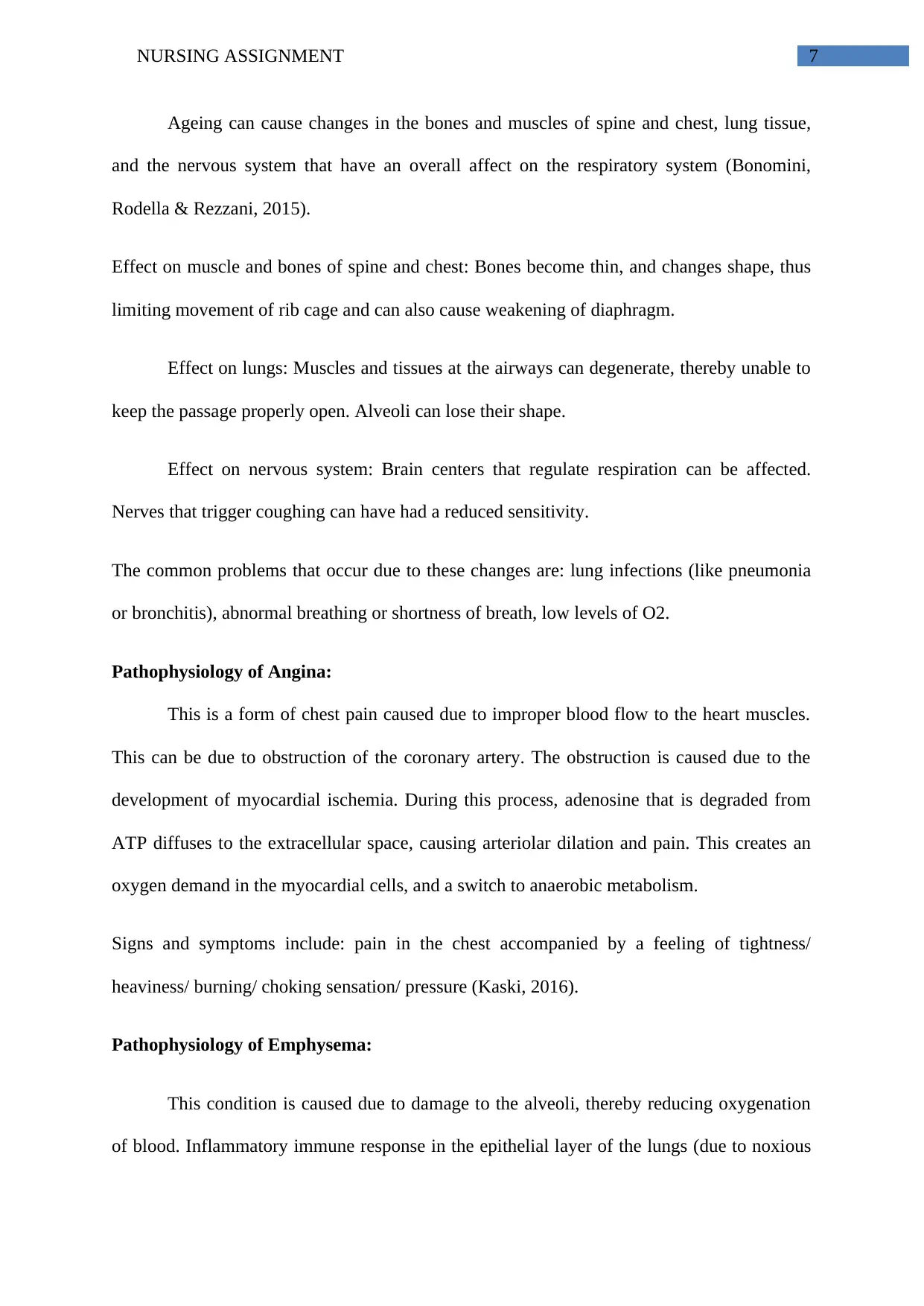
NURSING ASSIGNMENT 7
Ageing can cause changes in the bones and muscles of spine and chest, lung tissue,
and the nervous system that have an overall affect on the respiratory system (Bonomini,
Rodella & Rezzani, 2015).
Effect on muscle and bones of spine and chest: Bones become thin, and changes shape, thus
limiting movement of rib cage and can also cause weakening of diaphragm.
Effect on lungs: Muscles and tissues at the airways can degenerate, thereby unable to
keep the passage properly open. Alveoli can lose their shape.
Effect on nervous system: Brain centers that regulate respiration can be affected.
Nerves that trigger coughing can have had a reduced sensitivity.
The common problems that occur due to these changes are: lung infections (like pneumonia
or bronchitis), abnormal breathing or shortness of breath, low levels of O2.
Pathophysiology of Angina:
This is a form of chest pain caused due to improper blood flow to the heart muscles.
This can be due to obstruction of the coronary artery. The obstruction is caused due to the
development of myocardial ischemia. During this process, adenosine that is degraded from
ATP diffuses to the extracellular space, causing arteriolar dilation and pain. This creates an
oxygen demand in the myocardial cells, and a switch to anaerobic metabolism.
Signs and symptoms include: pain in the chest accompanied by a feeling of tightness/
heaviness/ burning/ choking sensation/ pressure (Kaski, 2016).
Pathophysiology of Emphysema:
This condition is caused due to damage to the alveoli, thereby reducing oxygenation
of blood. Inflammatory immune response in the epithelial layer of the lungs (due to noxious
Ageing can cause changes in the bones and muscles of spine and chest, lung tissue,
and the nervous system that have an overall affect on the respiratory system (Bonomini,
Rodella & Rezzani, 2015).
Effect on muscle and bones of spine and chest: Bones become thin, and changes shape, thus
limiting movement of rib cage and can also cause weakening of diaphragm.
Effect on lungs: Muscles and tissues at the airways can degenerate, thereby unable to
keep the passage properly open. Alveoli can lose their shape.
Effect on nervous system: Brain centers that regulate respiration can be affected.
Nerves that trigger coughing can have had a reduced sensitivity.
The common problems that occur due to these changes are: lung infections (like pneumonia
or bronchitis), abnormal breathing or shortness of breath, low levels of O2.
Pathophysiology of Angina:
This is a form of chest pain caused due to improper blood flow to the heart muscles.
This can be due to obstruction of the coronary artery. The obstruction is caused due to the
development of myocardial ischemia. During this process, adenosine that is degraded from
ATP diffuses to the extracellular space, causing arteriolar dilation and pain. This creates an
oxygen demand in the myocardial cells, and a switch to anaerobic metabolism.
Signs and symptoms include: pain in the chest accompanied by a feeling of tightness/
heaviness/ burning/ choking sensation/ pressure (Kaski, 2016).
Pathophysiology of Emphysema:
This condition is caused due to damage to the alveoli, thereby reducing oxygenation
of blood. Inflammatory immune response in the epithelial layer of the lungs (due to noxious
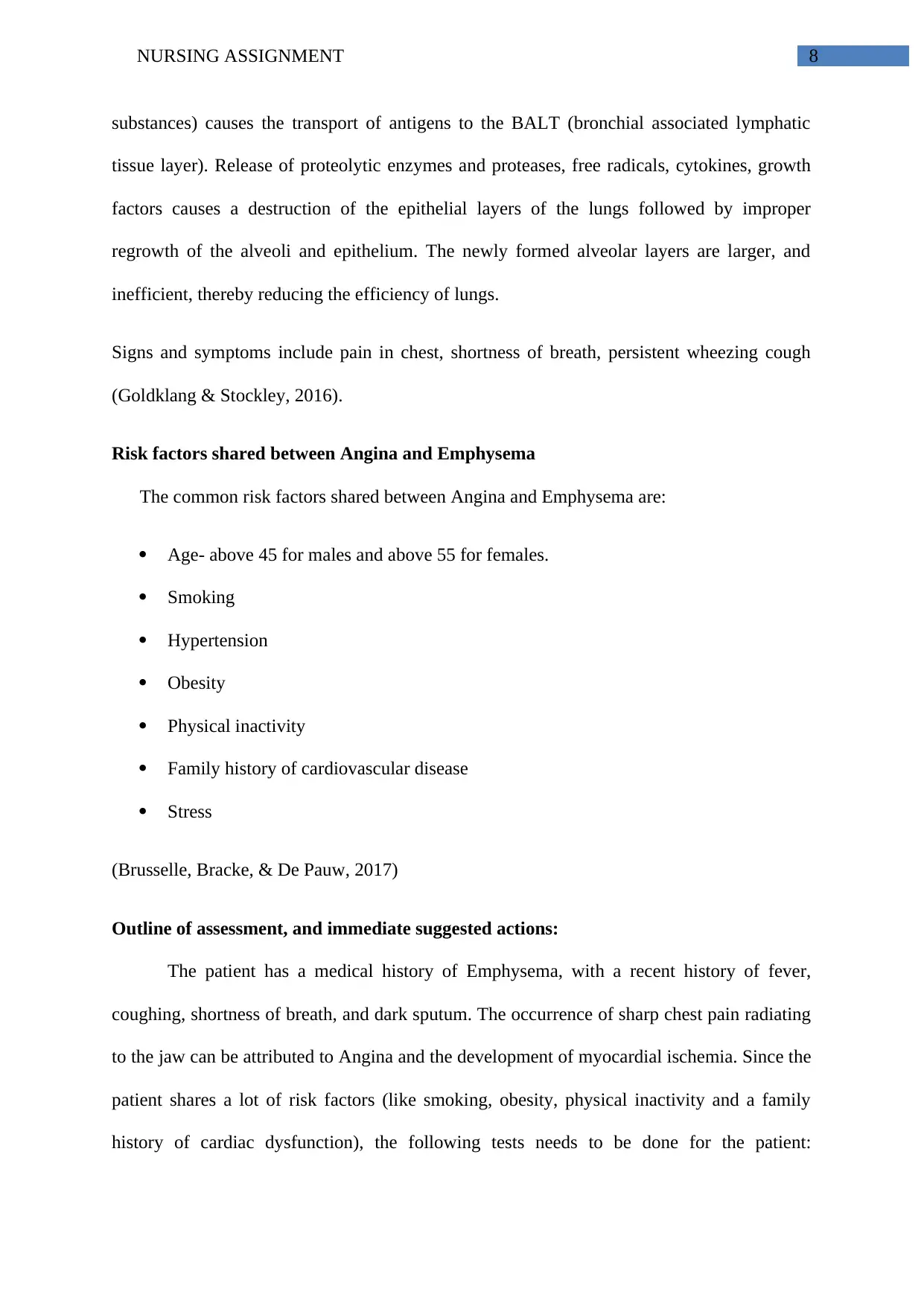
NURSING ASSIGNMENT 8
substances) causes the transport of antigens to the BALT (bronchial associated lymphatic
tissue layer). Release of proteolytic enzymes and proteases, free radicals, cytokines, growth
factors causes a destruction of the epithelial layers of the lungs followed by improper
regrowth of the alveoli and epithelium. The newly formed alveolar layers are larger, and
inefficient, thereby reducing the efficiency of lungs.
Signs and symptoms include pain in chest, shortness of breath, persistent wheezing cough
(Goldklang & Stockley, 2016).
Risk factors shared between Angina and Emphysema
The common risk factors shared between Angina and Emphysema are:
Age- above 45 for males and above 55 for females.
Smoking
Hypertension
Obesity
Physical inactivity
Family history of cardiovascular disease
Stress
(Brusselle, Bracke, & De Pauw, 2017)
Outline of assessment, and immediate suggested actions:
The patient has a medical history of Emphysema, with a recent history of fever,
coughing, shortness of breath, and dark sputum. The occurrence of sharp chest pain radiating
to the jaw can be attributed to Angina and the development of myocardial ischemia. Since the
patient shares a lot of risk factors (like smoking, obesity, physical inactivity and a family
history of cardiac dysfunction), the following tests needs to be done for the patient:
substances) causes the transport of antigens to the BALT (bronchial associated lymphatic
tissue layer). Release of proteolytic enzymes and proteases, free radicals, cytokines, growth
factors causes a destruction of the epithelial layers of the lungs followed by improper
regrowth of the alveoli and epithelium. The newly formed alveolar layers are larger, and
inefficient, thereby reducing the efficiency of lungs.
Signs and symptoms include pain in chest, shortness of breath, persistent wheezing cough
(Goldklang & Stockley, 2016).
Risk factors shared between Angina and Emphysema
The common risk factors shared between Angina and Emphysema are:
Age- above 45 for males and above 55 for females.
Smoking
Hypertension
Obesity
Physical inactivity
Family history of cardiovascular disease
Stress
(Brusselle, Bracke, & De Pauw, 2017)
Outline of assessment, and immediate suggested actions:
The patient has a medical history of Emphysema, with a recent history of fever,
coughing, shortness of breath, and dark sputum. The occurrence of sharp chest pain radiating
to the jaw can be attributed to Angina and the development of myocardial ischemia. Since the
patient shares a lot of risk factors (like smoking, obesity, physical inactivity and a family
history of cardiac dysfunction), the following tests needs to be done for the patient:
⊘ This is a preview!⊘
Do you want full access?
Subscribe today to unlock all pages.

Trusted by 1+ million students worldwide
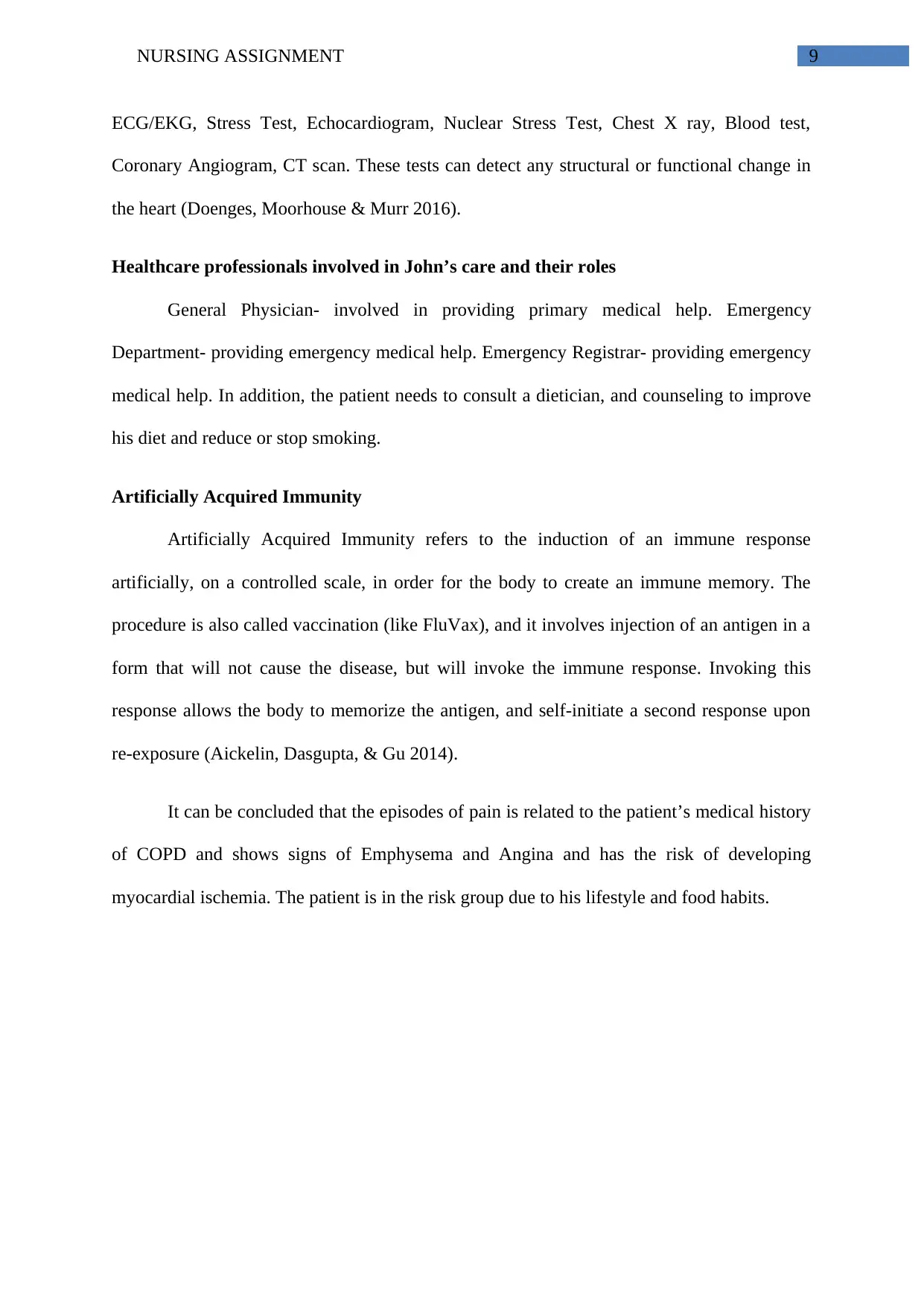
NURSING ASSIGNMENT 9
ECG/EKG, Stress Test, Echocardiogram, Nuclear Stress Test, Chest X ray, Blood test,
Coronary Angiogram, CT scan. These tests can detect any structural or functional change in
the heart (Doenges, Moorhouse & Murr 2016).
Healthcare professionals involved in John’s care and their roles
General Physician- involved in providing primary medical help. Emergency
Department- providing emergency medical help. Emergency Registrar- providing emergency
medical help. In addition, the patient needs to consult a dietician, and counseling to improve
his diet and reduce or stop smoking.
Artificially Acquired Immunity
Artificially Acquired Immunity refers to the induction of an immune response
artificially, on a controlled scale, in order for the body to create an immune memory. The
procedure is also called vaccination (like FluVax), and it involves injection of an antigen in a
form that will not cause the disease, but will invoke the immune response. Invoking this
response allows the body to memorize the antigen, and self-initiate a second response upon
re-exposure (Aickelin, Dasgupta, & Gu 2014).
It can be concluded that the episodes of pain is related to the patient’s medical history
of COPD and shows signs of Emphysema and Angina and has the risk of developing
myocardial ischemia. The patient is in the risk group due to his lifestyle and food habits.
ECG/EKG, Stress Test, Echocardiogram, Nuclear Stress Test, Chest X ray, Blood test,
Coronary Angiogram, CT scan. These tests can detect any structural or functional change in
the heart (Doenges, Moorhouse & Murr 2016).
Healthcare professionals involved in John’s care and their roles
General Physician- involved in providing primary medical help. Emergency
Department- providing emergency medical help. Emergency Registrar- providing emergency
medical help. In addition, the patient needs to consult a dietician, and counseling to improve
his diet and reduce or stop smoking.
Artificially Acquired Immunity
Artificially Acquired Immunity refers to the induction of an immune response
artificially, on a controlled scale, in order for the body to create an immune memory. The
procedure is also called vaccination (like FluVax), and it involves injection of an antigen in a
form that will not cause the disease, but will invoke the immune response. Invoking this
response allows the body to memorize the antigen, and self-initiate a second response upon
re-exposure (Aickelin, Dasgupta, & Gu 2014).
It can be concluded that the episodes of pain is related to the patient’s medical history
of COPD and shows signs of Emphysema and Angina and has the risk of developing
myocardial ischemia. The patient is in the risk group due to his lifestyle and food habits.
Paraphrase This Document
Need a fresh take? Get an instant paraphrase of this document with our AI Paraphraser
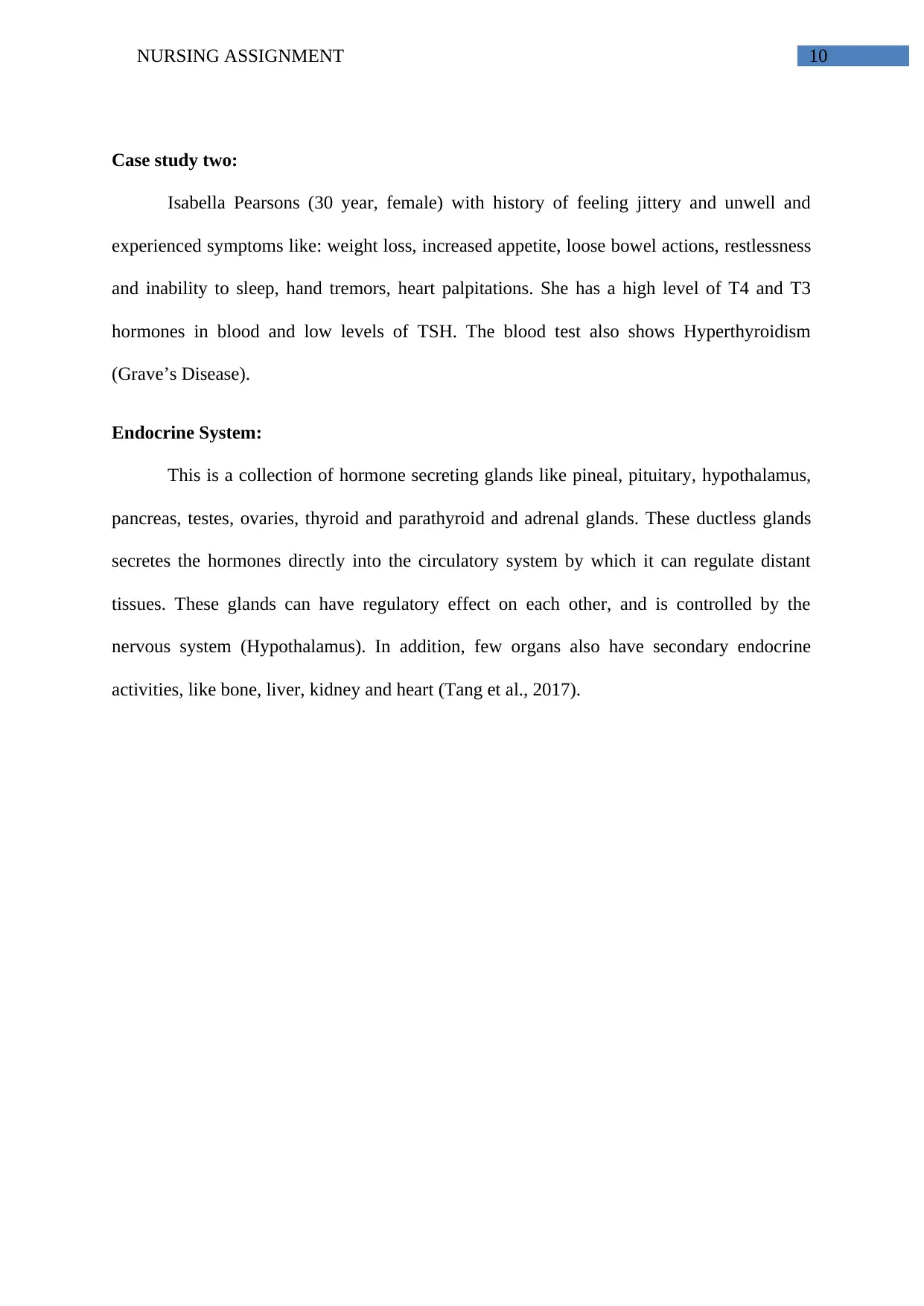
NURSING ASSIGNMENT 10
Case study two:
Isabella Pearsons (30 year, female) with history of feeling jittery and unwell and
experienced symptoms like: weight loss, increased appetite, loose bowel actions, restlessness
and inability to sleep, hand tremors, heart palpitations. She has a high level of T4 and T3
hormones in blood and low levels of TSH. The blood test also shows Hyperthyroidism
(Grave’s Disease).
Endocrine System:
This is a collection of hormone secreting glands like pineal, pituitary, hypothalamus,
pancreas, testes, ovaries, thyroid and parathyroid and adrenal glands. These ductless glands
secretes the hormones directly into the circulatory system by which it can regulate distant
tissues. These glands can have regulatory effect on each other, and is controlled by the
nervous system (Hypothalamus). In addition, few organs also have secondary endocrine
activities, like bone, liver, kidney and heart (Tang et al., 2017).
Case study two:
Isabella Pearsons (30 year, female) with history of feeling jittery and unwell and
experienced symptoms like: weight loss, increased appetite, loose bowel actions, restlessness
and inability to sleep, hand tremors, heart palpitations. She has a high level of T4 and T3
hormones in blood and low levels of TSH. The blood test also shows Hyperthyroidism
(Grave’s Disease).
Endocrine System:
This is a collection of hormone secreting glands like pineal, pituitary, hypothalamus,
pancreas, testes, ovaries, thyroid and parathyroid and adrenal glands. These ductless glands
secretes the hormones directly into the circulatory system by which it can regulate distant
tissues. These glands can have regulatory effect on each other, and is controlled by the
nervous system (Hypothalamus). In addition, few organs also have secondary endocrine
activities, like bone, liver, kidney and heart (Tang et al., 2017).

NURSING ASSIGNMENT 11
[Figure 3: Endocrine System. Source:
https://www.pinterest.com/ghkageyama/endocrine-system/]
Function of the Endocrine System:
Endocrine System acts like information signaling system, as in case of nervous
system, however acting much slower than them, with the effects being more prolonged, and
following different mechanism. The system regulates the metabolic activities of distant
tissues, mediated by the action of hormones that are secreted into the circulatory system. The
system is controlled by the Hypothalamus. Often the signals are transmitted sequentially from
one gland to the other, following an axis (hypothalamic-pituitary-thyroid axis) (Tang et al.,
2017).
[Figure 3: Endocrine System. Source:
https://www.pinterest.com/ghkageyama/endocrine-system/]
Function of the Endocrine System:
Endocrine System acts like information signaling system, as in case of nervous
system, however acting much slower than them, with the effects being more prolonged, and
following different mechanism. The system regulates the metabolic activities of distant
tissues, mediated by the action of hormones that are secreted into the circulatory system. The
system is controlled by the Hypothalamus. Often the signals are transmitted sequentially from
one gland to the other, following an axis (hypothalamic-pituitary-thyroid axis) (Tang et al.,
2017).
⊘ This is a preview!⊘
Do you want full access?
Subscribe today to unlock all pages.

Trusted by 1+ million students worldwide
1 out of 25
Related Documents
Your All-in-One AI-Powered Toolkit for Academic Success.
+13062052269
info@desklib.com
Available 24*7 on WhatsApp / Email
![[object Object]](/_next/static/media/star-bottom.7253800d.svg)
Unlock your academic potential
Copyright © 2020–2025 A2Z Services. All Rights Reserved. Developed and managed by ZUCOL.





